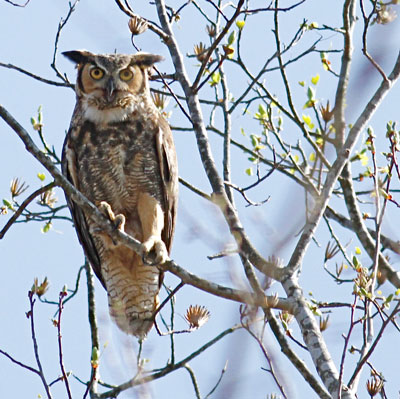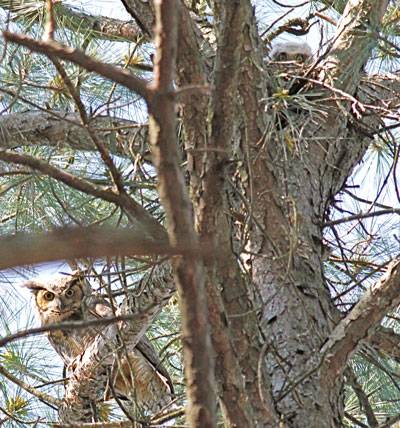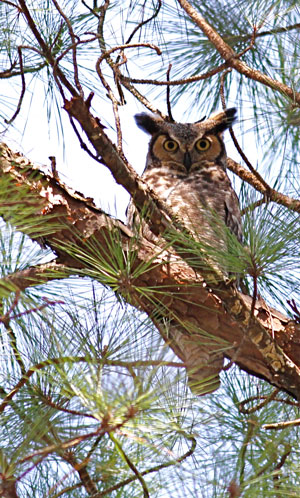
by Mary Parker Sonis
It was Feb. 20 of this year when Carrboro received its lone snowfall of the season. I went for an evening walk to my favorite pasture. The coyotes were yelping in the forest next to the field, the deer herd was walking the pasture, heads lowered against the wind, and to my great delight, I heard the calls of our Bolin Forest great horned owls. The snow wouldn’t last, but it covered the pasture and made for a beautiful twilight scene.
I had my search point. I fixed my attention on the calls of the owls and knew that the nest was somewhere in the dense band of pines by the edge of the farmer’s field. When you hear great horned owls calling together in February, you know they are at a nest, but the challenge is finding that nest.

Every day following, I took my walk, making sure to include a loop in the tall pines that edge the field. Great horned owls nest in the forest, but they hunt in open meadows. With a wingspan that can approach five feet, the great horned is not a creature of cramped spaces.
It was on my final homeward stretch of a March walk when the error was made. The male owl flew a short distance from one pine to another. From 100 yards away, he was a mere outline of dark-grayish brown, but this was a massive bird. I kept my eyes always up in the canopy and headed toward the owl tree. These head-up bird quests always land me in a ditch. Owls are smart. If you put your head down, they will fly off while you aren’t looking, so you keep your eyes fixed on the target tree and hope you don’t land facedown. I was thrilled. The owl held tight in the pine and I managed one grainy photo from a distance. But more importantly, I knew the nest was within a circle of about three acres.
How did I know it was a male owl? Well, the male great horned owl is the sentry of the family. When any possible threat comes to the nest area, the male owl flies away and distracts the predator. Crows and red-shouldered hawks harass the owls all day long. It is the job of the male owl to expose himself to the mob and then lead them on a grand chase through the woods, while the female owl is always guarding the nestling. She broods the eggs and guards her young, but she does not leave the immediate vicinity of the nest. During the brooding period it is also the male’s responsibility to do all the hunting for the pair.
The search was on at first light the following morning. I wandered the pines looking for that nest, and my first sighting was the male owl on a high exposed snag. The crows caught sight of him, and the chase was on. I watched him fly from tree to tree with as many as six crows and three red-shouldered hawks screaming behind him through the canopy.
I held my position, looking from branch to branch for that brown football-shaped outline. Just up to my left, I finally saw the female owl staring down at me. She had been watching me the entire time from a perch about 50 feet in the air. But where was the nest? It had to be close, though not very close, as the female owl is not foolish enough to lead potential predators to her owlets, but she also will keep the nest in sight, just in case she needs to defend her young.

I checked every clump of pine needles that occupied the highest part of the forest, since this owl doesn’t like to nest low. I have learned from experience that they prefer pines, which are dense and provide good cover. In my search, I found multiple old hawks’ nests. Tree by tree I checked, noting which trees had big clumps of sticks lodged in their branches, but not one tree appeared occupied. No heads peeked out from any of the clumps. I was pleased to have photographed the parents, but the young were still out of sight.
The next morning, it was time to check the canopy again. The adult owls were flying about, but I was checking the ground and the pines for evidence. I hit gold as I was circling one of the tallest, largest pines in the area. A great many white bird droppings littered the ground and the sides of the tree, indicating that some large bird had been roosting at this tree.
Another circle of the tree and I found what I was looking for – an owl pellet. This pellet was massive, covering my palm. I knew that an owl had been roosting and eating at this very tree.
I stepped back and looked straight up, but saw only a meager group of sticks at the very top crotch of the tree. I backed out farther and looked up at that paltry clump of sticks. Was that peach-colored bit of debris pine needles or the top of an owlet head? My telephoto lens answered the question – it was clearly the top of an owlet’s head. Downy, peach-colored fuzz framed a dark beak and glowing yellow eyes. The dark outline of black that would eventually frame the great horned owl’s facial mask was already visible. The ear tufts that give the owl its name were barely discernable buttons of fluff.

Imagine how vulnerable the owl family is when the young are nestbound. They must be guarded from hawks and crows 24 hours a day, and no matter what occurs, the pair cannot leave the vicinity. The female is fully up to the task. She will attack and kill any creature that approaches those owlets, as I was soon to discover.
I restricted my visits to the nest to every three days, as I didn’t want to stress the owls with my constant presence. Observations were kept to 10 minutes, during which time I would take my photos and examine the area around the nest. The discoveries were gruesome. When I imagined the owl hunting for prey, I pictured a few voles neatly swallowed in one gulp, but I had no clue that I would be witnessing carnage of such magnitude.
As the days progressed and the owlets grew larger, the area around the nest became a killing field. One morning, I discovered an entire rabbit haunch on the ground. It had most likely been accidentally jettisoned from the nest by the growing, active owlets. Carrion beetles crawled through the remains and flies hovered by the base of the tree. A puddle of gray and pink feathers marked the spot where a dove paid with its life for its ground-eating habits.

Another morning, a large liver of some unknown mammal lay in the leaf litter. The vague smell of carrion filled the air with its cloying odor. Squirrel tails littered the periphery and a crow leg (still attached to a meaty thigh) stood up from the ground as a warning to the harassing mob.
The great horned owl is a brutal killer. While the barred owl is a scrappy, street-fighting hooligan that occasionally strafes a runner by the creek, the great horned owl is the silent executioner, “the fatal bellman that gives the stern’st goodnight.†The very call of this owl (a somber five-note hoot) strikes fear in every single creature of the forest. No predator of Bolin Creek can match the fierce power of this bird. In its vise-like grip, the owl can carry off more than its own weight. These owls were feeding their young easily. Indeed, a surfeit of food littered the ground. The beautiful great horned owl is not the sage old guardian of the forest that we know from storybooks, but more accurately the rapacious warlord of its domain.
I had only one close call with the female owl. Somehow she forgot that I was under the nest tree, waiting for the sun to illuminate the young owls better. I was blocked from her field of vision by other trees, and I was standing motionless. The female owl arrived at the nest to give care to her owlets. She would never have flown to the nest had she known that a predator was nearby. She is not afraid in the least, but she is very careful not to draw attention to her young.
She settled in on a close limb, but suddenly saw me in the periphery. I felt her eyes lock on me. For one moment, she leaned forward aggressively and prepared to dive. I kept my focus on her and she redirected her flight to a nearby branch. Knowing that she was agitated, I held my monopod above my head and kept my eyes on her as I backed quietly away from the nest zone.
Both owlets fledged successfully. They are robust birds that still receive constant care from their parents. The male draws the crows away from the juveniles while the female perches close where she can protect her young should they need help. Bolin Forest now has four great horned owls roaming the canopy and hunting the great pasture. The young owls will receive care and training from their parents for another two months before the youngsters strike out on their own to establish a territory.
Little do the owls realize they will soon face a most dangerous foe. Carrboro’s Board of Aldermen has given final approval to the development of Claremont South. The 38-acre field will soon be the site for 92 residential units, along with commercial space. The field, which has long been the domain of this great raptor, will no longer exist. How will our owls fare against bulldozers and sheetrock? Perhaps there is something more rapacious than the great horned owl.